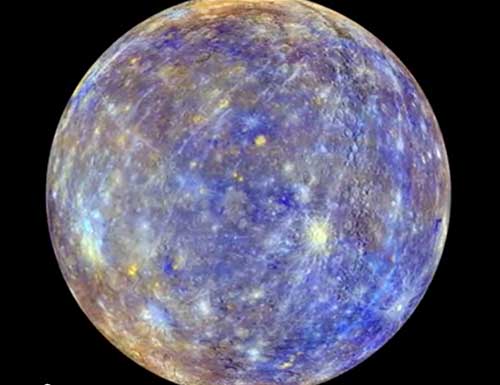

Mercury is the innermost planet in the Solar System. It is also the smallest, and its orbit is the most eccentric (that is, the least perfectly circular) of the eight planets. It orbits the Sun once in about 88 Earth days, completing three rotations about its axis for every two orbits. The planet is named after the Roman god Mercury, the messenger to the gods.
Mercury's surface is heavily cratered and similar in appearance to Earth's Moon, indicating that it has been geologically inactive for billions of years. Due to its near lack of an atmosphere to retain heat, Mercury's surface experiences the steepest temperature gradient of all the planets, ranging from a very cold 100 K at night to a very hot 700 K during the day.
Mercury's axis has the smallest tilt of any of the Solar System's planets, but Mercury's orbital eccentricity is the largest. The seasons on the planet's surface are caused by the variation of its distance from the Sun rather than by the axial tilt, which is the main cause of seasons on Earth and other planets. At perihelion, the intensity of sunlight on Mercury's surface is more than twice the intensity at aphelion. Because the seasons of the planet are produced by the orbital eccentricity instead of the axial tilt, the season does not differ between its two hemispheres.
Because Mercury's orbit lies within Earth's orbit (as does Venus'), it can appear in Earth's sky either as a morning star or an evening star. While Mercury can appear as a very bright object when viewed from Earth, its proximity to the Sun makes it more difficult to see than Venus.
The perihelion of Mercury's orbit precesses around the Sun at an excess of 43 arcseconds per century; a phenomenon that was explained in the 20th century by Albert Einstein's General Theory of Relativity.
Mercury is bright when viewed from Earth, ranging from -2.3 to 5.7 in apparent magnitude, but is not easily seen as its greatest angular separation from the Sun is only 28.3¡. Since Mercury is normally lost in the glare of the Sun, unless there is a solar eclipse it can be viewed from Earth's Northern Hemisphere only in morning or evening twilight, while its extreme elongations occur in declinations south of the celestial equator, such that it can be seen at favorable apparitions from moderate latitudes in the Southern Hemisphere in a fully dark sky. Read More ...
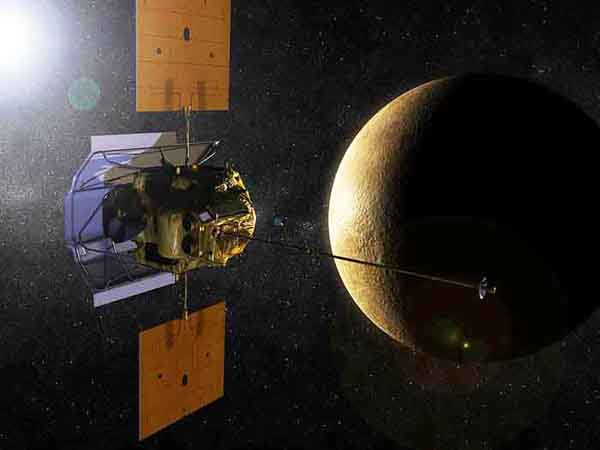
Mercury MESSENGER Explorations
See Mercury's frigid north pole in extraordinary new images from the BepiColombo spacecraft Live Science - January 14, 2025
Mysterious 'Singing' Plasma Waves Detected Around Mercury Science Alert - October 16, 2023
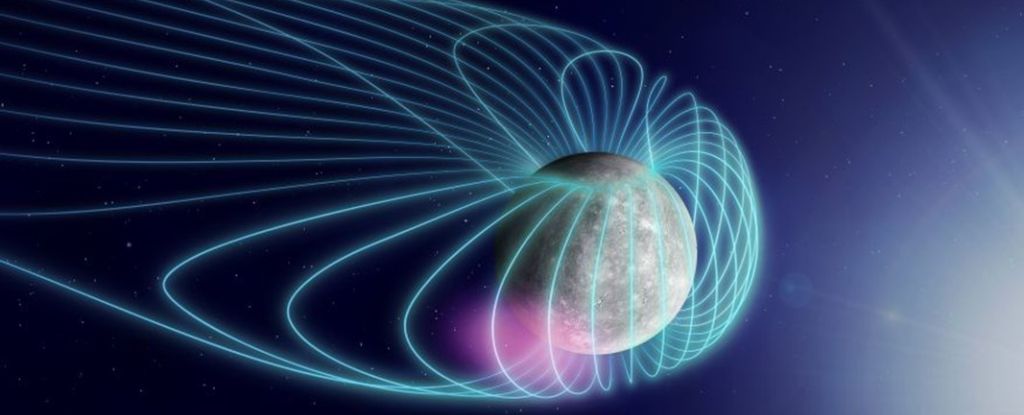
Around planets that have a magnetosphere, something magical happens. If you listen with the right instruments, you can hear chirping and whistling ...
Mercury Is a Planet With a Tail. Here's How That's Possible Science Alert - January 8, 2021
The planets of the Solar System look a lot like a family. Jupiter's the bossy dad, keeping everyone in line. Uranus and Neptune are the cool twins who only hang out with each other. Earth is the super-nerd try-hard. Pluto is the black sheep. And Mercury has a tail.
Mercury's crust is thinner than anyone thought, new mathematical calculations reveal Science Daily - April 27, 2018
Using the most recent mathematical formulas, Lunar and Planetary Laboratory associate staff estimates that the Mercurial crust is just 16 miles thick and is denser than aluminum.
Mercury found to be tectonically active PhysOrg - September 26, 2016
Images acquired by NASA's MErcury Surface, Space ENvironment, GEochemistry, and Ranging (MESSENGER) spacecraft show geologic features that indicate Mercury is likely still contracting today, joining Earth as a tectonically active planet in our Solar System. Previously undetected small fault scarps were observed in images collected during the MESSENGER mission's final 18 months in orbit around Mercury, according to a new paper in Nature Geoscience. During these last months of the mission, the spacecraft's altitude was lowered allowing the surface to be imaged at higher resolutions than ever before possible.
Stunning topographic model of Mercury reveals its craters and mountains in unprecedented detail Daily Mail - May 7, 2016
Astronomers have unveiled a high-resolution animated map of Mercury providing the first topographic view of the planet's entire surface, showing its craters, volcanoes and mountains. 'It brings together more than 100,000 images of the planet taken by Nasa's Messenger spacecraft, whose mission included 4,104 orbits around the planet.
Mystery on Mercury: Strange Pattern of Huge Cliffs Defy Explanation Live Science - June 11, 2015
A baffling new mystery has turned up on Mercury - a pattern of giant cliffs and ridges on the planet's surface that defies any explanation that scientists have currently been able to offer.
Mercury is the solar system's smallest and innermost world. It was an enigmatic planet for years. Until NASA's MESSENGER spacecraft became the first probe to orbit Mercury, the only other visits it received were the flybys made by NASA's Mariner 10 probe four decades ago. MESSENGER ended its mission in April by crashing into Mercury's surface. Images that MESSENGER collected during its more than four years in orbit revealed a vast array of large fault scarps, or cliffs, on Mercury. These scarps resemble giant stair steps in the landscape - the largest are more than 600 miles (1,000 kilometers) long and more than 1.8 miles (3 km) high.
Space probe crashes into Mercury, ending mission CNN - April 30, 2015
Messenger's Mercury trip ends with a bang, and silence BBC - April 30, 2015
Nasa's Messenger mission to Mercury has reached its explosive conclusion, after 10 years in space and four in orbit. Now fully out of fuel, the spacecraft smashed into a region near Mercury's north pole, out of sight from Earth, at about 20:00 GMT on Thursday. Mission scientists confirmed the impact minutes later, when the craft's next possible communication pass was silent. Messenger reached Mercury in 2011 and far exceeded its primary mission plan of one year in orbit. That mission ended with an inevitable collision: Messenger slammed into our Solar System's smallest planet at 8,750mph (14,000km/h) - 12 times quicker than the speed of sound. The impact will have completely obliterated this history-making craft. And it only happened because Mercury has no thick atmosphere to burn up incoming objects - the same reason its surface is so pock-marked by impact craters.
Mercury's bizzare magnetic field tells scientists how its interior is different from Earth's Science Daily - July 30, 2014
Mercury's interior is different from the Earth's interior in a way that explains Mercury's bizarre magnetic field, planetary physicists report. Measurements from NASA's Messenger spacecraft have revealed that Mercury's magnetic field is approximately three times stronger at its northern hemisphere than its southern one.
Planet Mercury a result of early hit-and-run collisions Science Daily - July 8, 2014
New simulations show that Mercury and other unusually metal-rich objects in the solar system may be relics left behind by hit-and-run collisions in the early solar system. The origin of planet Mercury has been a difficult question in planetary science because its composition is very different from that of the other terrestrial planets and the moon.
NASA's Messenger spots giant space weather effects at Mercury PhysOrg - June 17, 2014
The solar wind of particles streaming off the sun helps drive flows and swirls in space as complicated as any terrestrial weather pattern. Scientists have now spotted at planet Mercury, for the first time, a classic space weather event called a hot flow anomaly, or HFA, which has previously been spotted at Earth, Venus, Saturn and Mars.
All of Mercury NASA - June 12, 2013
For the first time, the entire surface of planet Mercury has been mapped. Detailed observations of the innermost planet's surprising crust have been ongoing since the robotic MESSENGER spacecraft first passed Mercury in 2008 and began orbiting in 2011. Previously, much of the Mercury's surface was unknown as it is too far for Earth-bound telescopes to see clearly, while the Mariner 10 flybys in the 1970s observed only about half. The video above is a compilation of thousands of images of Mercury rendered in exaggerated colors to better contrast different surface features. Visible on the rotating world are rays emanating from a northern impact that stretch across much of the planet, while about half-way through the video the light colored Caloris Basin rotates into view, a northern ancient impact feature that filled with lava. MESSENGER has now successfully completed its primary and first extended missions.
NASA Spacecraft Makes 1st Complete Map of Planet Mercury Live Science - March 6, 2013
The surface of the planet Mercury has been completely mapped for the first time in history, scientists say. The closest planet to the sun hasn't received as much scientific attention as some of its more flashy solar system neighbors, such as Mars, but NASA's Messenger spacecraft is helping to close the gap.
Colors of Mercury NASA - March 1, 2013
The colors of the solar system's innermost planet are enhanced in this tantalizing view, based on global image data from the Mercury-orbiting MESSENGER spacecraft. Human eyes would not discern the clear color differences but they are real none the less, indicating distinct chemical, mineralogical, and physical regions across the cratered surface. Notable at the upper right, Mercury's large, circular, tan colored feature known as the Caloris basin was created by an impacting comet or asteroid during the solar system's early years. The ancient basin was subsequently flooded with lava from by volcanic activity, analogous to the formation of the lunar maria. Color contrasts also make the light blue and white young crater rays, material blasted out by recent impacts, easy to follow as they extend across a darker blue, low reflectance terrain.
Mercury's magnetic field -- nipped in the bud PhysOrg - December 23, 2011
Mercury, the smallest of the eight planets with a diameter of 4900 kilometres and the closest to the Sun, looks more like the Moon than the Earth from the outside. It is the only rocky planet that has a global magnetic field like Earth. But why is its magnetic field so much weaker than Earth's? Possible explanation: the solar wind counteracts Mercury's internal dynamo and thus weakens its magnetic field.
Epic volcanic activity flooded Mercury's north polar region PhysOrg - September 29, 2011
Ever since the Mariner 10 mission in 1974 snapped the first pictures of Mercury, planetary scientists have been intrigued by smooth plains covering parts of the surface. Some suspected past volcanic activity, but there were no telltale signs like protruding volcanoes. Also, Mercury's northern plains are the same brightness as its cratered highlands, yet different from volcanic deposits on the Moon, which are darker than the highlands.
Mercury's youngest volcano found BBC - July 16, 2010
Scientists analyzing data from Nasa's Messenger spacecraft say they have located some of Mercury's most recent volcanic activity.
This indicates that rather than being a tiny, long-dead planet, as scientists had assumed, Mercury was volcanically active for much of its "life". The researchers say it also sheds light on how other planets in our Solar System evolved.
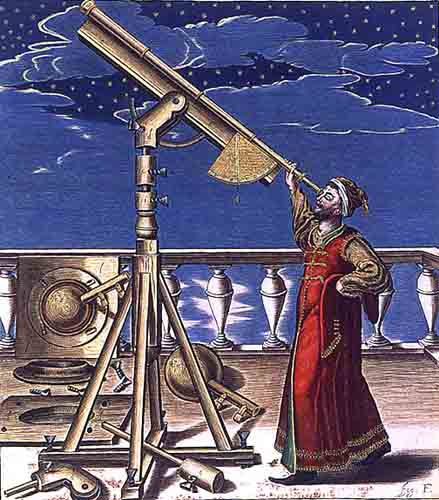
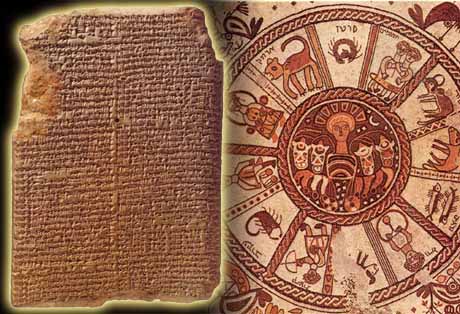
The earliest known recorded observations of Mercury are from the Mul.Apin tablets - the conventional title given to a Babylonian compendium that deals with many diverse aspects of Babylonian astrology. The tablet is in the tradition of earlier star catalogues, the so-called Three Stars Each lists, but represents an expanded version based on more accurate observation, likely compiled around 1000 BC. The text lists the names of 66 stars and constellations and further gives a number of indications, such as rising, setting and culmination dates, that help to map out the basic structure of the Babylonian star map. These observations were most likely made by an Assyrian astronomer around the 14th century BC. The cuneiform name used to designate Mercury on the Mul.Apin tablets is transcribed as Udu.Idim.Gu\u4.Ud ("the jumping planet").
Babylonian records of Mercury date back to the 1st millennium BC. The Babylonians called the planet Nabu after the messenger to the gods in their mythology.
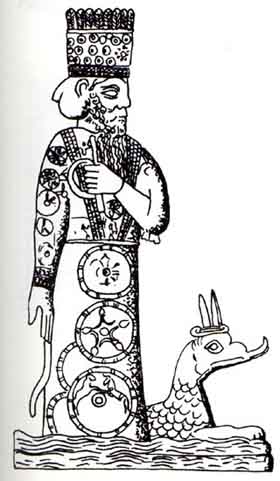
Nabu (in Biblical Hebrew Nebo) is the Assyrian and Babylonian god of wisdom and writing, worshipped by Babylonians as the son of Marduk and his consort, Sarpanitum, and as the grandson of Ea. Nabu's consort was Tashmetum.
Originally, Nabu was a West Semitic deity introduced by the Amorites into Mesopotamia, probably at the same time as Marduk shortly after 2000 BC. While Marduk became Babylon's main deity, Nabu resided in nearby Borsippa in his temple E-zida. He was first called the "scribe and minister of Marduk", later assimilated as Marduk's beloved son from Sarpanitum. During the Babylonian New Year Festival, the cult statue of Nabu was transported from Borsippa to Babylon in order to commune with his father Marduk.
Nabu later became one of the principal gods in Assyria and Assyrians addressed many prayers and inscriptions to Nabu and named children after him. Nabu was the god of writing and scribes and was the keeper of the Tablets of Destiny, in which the fate of humankind was recorded. He was also sometimes worshiped as a fertility god and as a god of water.
Nabu is accorded the office of patron of the scribes, taking over from the Sumerian goddess Nisaba. His symbols are the clay writing tablet with the writing stylus. He wears a horned cap, and stands with hands clasped, in the ancient gesture of priesthood. He rides on a winged dragon (also known as Sirrush) that is initially Marduk's.
His power over human existence is immense, because Nabu engraves the destiny of each person, as the gods have decided, on the tablets of sacred record. Thus, He has the power to increase or diminish, at will, the length of human life. Nabu is mentioned in the Nevi'im of the Tanakh as Nebo in Isaiah 46:1.
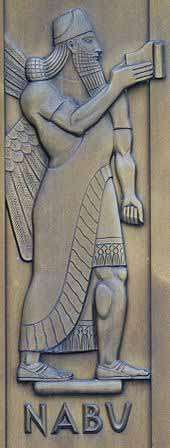
A statue of Nabu from Calah, erected during the reign of the Assyrian king, Tiglath-pileser III is on display in the British Museum.
In late Babylonian astrology, Nabu was connected with the planet Mercury. As the god of wisdom and writing, he was equated by the Greeks to either Apollo or Hermes, the latter identified by the Romans with their own god Mercury.
In ancient China, Mercury was known as Chen Xing, the Hour Star. It was associated with the direction north and the phase of water in the Wu Xing. However, modern Chinese, Korean, Japanese and Vietnamese cultures refer to the planet literally as the 'water star', based on the Five elements.
Hindu mythology used the name Buddha for Mercury, and this god was thought to preside over Wednesday.
The god Odin (or Woden) of Germanic paganism was associated with the planet Mercury and Wednesday.
The Maya may have represented Mercury as an owl (or possibly four owls; two for the morning aspect and two for the evening) that served as a messenger to the underworld.
In ancient Indian astronomy, the Surya Siddhanta, an Indian astronomical text of the 5th century, estimates the diameter of Mercury as 3,008 miles, an error of less than 1% from the currently accepted diameter of 3,032 miles. However, this estimate was based upon an inaccurate guess of the planet's angular diameter as 3.0 arcminutes.
In medieval Islamic astronomy, the Andalusian astronomer Abu Ishaq Ibrahim al-Zarqali in the 11th century described the deferent of Mercury's geocentric orbit as being oval, like an egg or a pignon, although this insight did not influence his astronomical theory or his astronomical calculations.
In the 12th century, Ibn Bajjah observed "two planets as black spots on the face of the Sun," which was later suggested as the transit of Mercury and/or Venus by the Maragha astronomer Qotb al-Din Shirazi in the 13th century.
In India, the Kerala school astronomer Nilakantha Somayaji in the 15th century developed a partially heliocentric planetary model in which Mercury orbits the Sun, which in turn orbits the Earth, similar to the Tychonic system later proposed by Tycho Brahe in the late 16th century.
The Romans named the planet after the swift-footed Roman messenger god, Mercury (Latin Mercurius), which they equated with the Greek Hermes, because it moves across the sky faster than any other planet. The Roman-Egyptian astronomer Ptolemy wrote about the possibility of planetary transits across the face of the Sun in his work Planetary Hypotheses. He suggested that no transits had been observed either because planets such as Mercury were too small to see, or because the transits were too infrequent.
Before the 4th century BC, Greek astronomers believed the planet to be two separate objects: one visible only at sunrise, which they called Apollo - the other visible only at sunset, which they named after the Greek god Hermes. The astronomical symbol for Mercury is a stylized version of Hermes' caduceus.
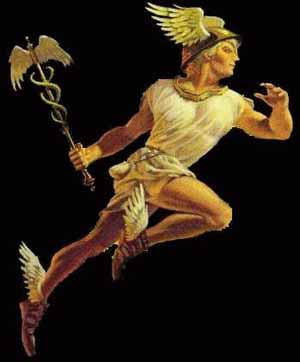
In Egypt he was the God Thoth.
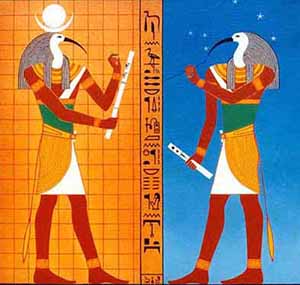
As one who flew with wings, Mercury is sometimes associated with Ancient Alien Theory and Angels.
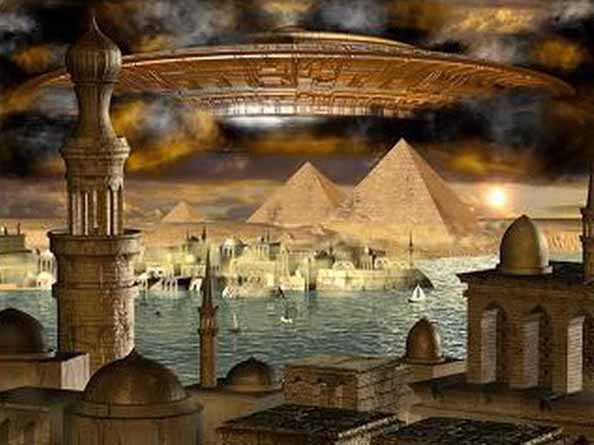
Mercury is the ruler of both Gemini and Virgo.
Mercury: The Mind, Transportation and Communication
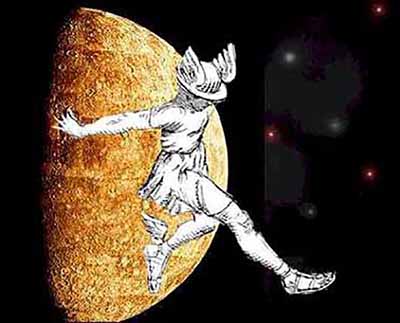
Mercury Retrograde
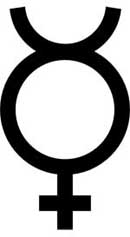
Alchemists often thought of Mercury as the First Matter from which all metals were formed. Different metals could be produced by varying the quality and quantity of sulfur contained within the mercury. An ability to transform mercury into any metal resulted from the essentially mercurial quality of all metals. The purest of these was gold. Mercury was required for the transmutation of base (or impure) metals into gold.
Gold is element 79 and Mercury is element 80 which means that there is only a slight difference between their atomic structures. Element 80
The element was named after the Roman god Mercury, known for speed and mobility. It is associated with the planet Mercury.
Hg is the modern chemical symbol for mercury. It comes from hydrargyrum, a Latinized form of the Greek word "hydrargyros", which is a compound word meaning 'water' and 'silver' - since it is liquid, like water, and yet has a silvery metallic sheen.
Mercury was known to the ancient Chinese and Hindus, and was found in Egyptian tombs that date from 1500 BC.
In China, India and Tibet, Mercury use was thought to prolong life, heal fractures, and maintain generally good health. China's first emperor, Qin Shi Huang Di was said to have been buried in a tomb that contained rivers of flowing mercury, representative of the rivers of China. He was ultimately driven insane and killed by mercury pills intended to give him eternal life.
The ancient Greeks used mercury in ointments and the Romans used it in cosmetics. By 500 BC mercury was used to make amalgams with other metals.
The Hindu word for alchemy is Rasavatam which means '"The way of Mercury".